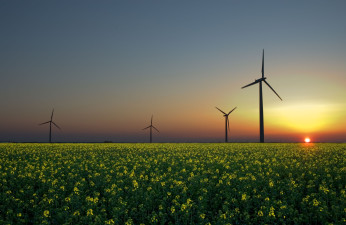By: Andrew Landrum, Associate Technical & Public Relations Editor
The clean energy industry has soared to new heights in recent years. Clean energy investment and development have continued to surge despite oil price fluctuations[1], and the Energy Industry Association predicts clean energy production capacity will increase by sixty percent between now and 2016.[2] New data shows that, concomitant to this expansion, clean energy patents have reached an industry high.[3] “Everyone is scrambling to stake out their territory and nobody knows how valuable the technology will be,” says C. Erik Hawes of Morgan Lewis & Bockius. “Those factors . . . have . . . [created] a gold rush on renewable patents[.]”[4] The skyrocketing rate of new clean energy patents will likely produce mixed results for market participants.
Patents serve a valuable role in development. They introduce new innovations to the public by requiring the dissemination of technical knowledge in exchange for exclusive rights over the technology.[5] Small businesses then have access to the patent’s information, which drastically reduces industry learning curves and encourages building upon successful ideas.[6] The Coalition for Innovation Development & Employment Alliance (IDEA) is a pro-business group launched by the United States Chamber of Commerce, which fights hard for powerful protections to the United States’ patent system. The patent system, IDEA says, is vital to a growing cleantech industry, which will result in the creation of millions of American jobs.[7]
However, the increase in clean energy patents may also burden companies with increased costs in litigation. Clean energy companies used to be able to avoid costly patent infringement battles.[8] But, with the increase in clean energy revenues, that may soon change.[9] Patent infringement suits are notoriously costly and recent clean energy cases have resulted in up to $170 million in damages.[10] Surveys show average infringement litigation costs generally run parties over $5 million, and generally last for two to four years.[11] The actual impact on cleantech patent litigation will be decided once the margin of growth stabilizes and the true value of clean energy is realized.[12]
But, the market is still growing and there are few big players in the renewable market. Once the market is established, however, the patent cases will follow. According to Ropes & Gray partner, William McCabe, “[o]nce [the companies] build the market, they will become targets of the smaller players and nonpracticing entities who would not find economic value in an injunction.” Solar and wind companies, in particular, will see an increase in patent infringement claims.[13] “Wind and photovoltaic solar are very complex technologies that require large capital investments[,]” says McCabe. “Those manufactures tend to be very large, sophisticated companies who tend to protect their IP rights and who don’t seem timid about protecting them via enforcement.”[14]
This is good news for attorneys as small and medium-sized clean energy companies will have to innovate and work hard to protect their product. These companies have an interest in creating strong, diverse energy patent portfolios, and will begin to take offensive measures to protect competitive technologies.[15] Building a patent portfolio may seem daunting, but the companies that get it done will be “be prepared for battle and will reap the rewards.”[16]
Ultimately, it is an exciting time to be involved in the clean energy market. The renewable patent explosion will continue for the foreseeable future. Federal and state support will continue to fund research and development, and the potential for green revenue is still uncertain. Patent attorneys should see this as a gold rush opportunity and work hard to protect the property of these clean energy startups. Once the patent system starts working for the cleantech companies, America’s “all-of-the-above” energy approach becomes that much more more accessible.
[1] Louise Downing, Clean Energy Investment Jumps 16% Shaking Off Oil’s Drop, Bloomberg (Jan. 9, 2015, 4:00 AM), available at http://www.bloomberg.com/news/articles/2015-01-09/clean-energy-investment-jumps-16-on-china-s-support-for-solar.
[2] U.S. Energy Information Administration, Short-Term Energy Outlook (2015), pp. 10-11, available at http://www.eia.gov/forecasts/steo/report/renew_co2.cfm (noting capacity increases by more than 60%).
[3] Clean Energy Patent Growth Index 2013 Year in Review, Cleantech Group (Apr. 23, 2014), http://www.cepgi.com/2014/04/clean-energy-patent-growth-index-2012-year-in-review.html#more.
[4] Keith Goldberg, Clean Energy Patent Boom Sets Stage for IP Wars, Law360 (Oct. 30, 2013, 6:09 PM), http://www.law360.com/articles/484594/clean-energy-patent-boom-sets-stage-for-ip-wars.
[5] Jeanne C. Fromer, Patent Disclosure, 94 Iowa L. Rev. 540, 548-50 (2009).
[6] Margaret McInerney, Note, Tacit Knowledge Transfer with Patent Law: Exploring Clean Technology Transfers, 21 Fordham Intell. Prop. Media & Ent. L.J. 449, 462 (2011).
[7] Eric Raciti, Is IP Standing in the Way of a Green Planet?, Renewable Energy World (Nov. 5, 2010), http://www.renewableenergyworld.com/rea/news/article/2010/11/is-ip-standing-in-the-way-of-a-green-planet.
[8] Goldberg, supra n. 3.
[9] Teague Donahey, Expect Patent Disputes to Accelerate as Clean Energy Expands, Green Tech Media (Oct. 6, 2014), http://www.greentechmedia.com/articles/read/patent-activity-in-clean-energy-picks-up.
[10] Jess Davis, Mitsubishi Can’t Knock Out $170M Wind Patent Judgment, Law360 (May 29, 2013, 2:00 PM), http://www.law360.com/articles/445617.
[11] Donahey, supra n. 10.
[12]Goldberg, supra n. 3.
[13] Id.
[14] Id.
[15] Donahey, supra n. 10.
[16] Teague Donahey, From Enphase to Wanxiang, How Cleantech Companies are Building Patent Portfolios, Green Tech Media (Doc. 17, 2014), http://www.greentechmedia.com/articles/read/as-patent-disputes-accelerate-clean-energy-firms-look-to-bolster-portfolios.

